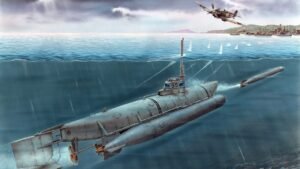Russia Tested Nuclear-Capable Poseidon Super Torpedo
|
General Studies Paper II: Impact of Policies and Politics of Countries on India’s Interests |
Why in News?
Recently, Russia tested its nuclear-capable Poseidon super torpedo, marking a major step in its underwater weapons program. The test was seen as a demonstration of Russia’s advanced naval strength.
Highlights of Russia’s Poseidon Super Torpedo Test
- Russia’s Poseidon Super Torpedo test was successfully conducted in October 2025.
- Under this test, the weapon was deployed from a submarine carrier, which executed the launch sequence for the first time.
- The carrier submarine initiated the launch engine, and then the device’s nuclear power unit became operational.
- The device utilises a nuclear-powered propulsion system, allowing extended underwater operation beyond traditional torpedoes.
- According to the announcement, the test was aimed at proving the full cycle: launch from submarine + activation of nuclear power unit + underwater propulsion for a defined time.
What is the Poseidon Super Torpedo?
- The Poseidon Super Torpedo is an unmanned underwater nuclear capable drone developed by Russia. It carries both nuclear and conventional payloads. The system was first revealed publicly in 2015 under the codename “Status-6”. It was officially named “Poseidon” in 2018.
- The core objective of the Poseidon is to provide a second-strike capability by reaching and destroying coastal infrastructure of an adversary.
- It aims to bypass traditional missile defences by travelling underwater at great depths and long ranges.
- It aims to impose unacceptable damage through radioactive contamination and possibly create a tsunami-effect off enemy shores.
- It can be deployed by specially built or modified submarines, including the Belgorod and Khabarovsk.
- The Poseidon is about 20 metres long and roughly 1.5–2 metres in diameter, according to open-source estimates.
- It is designed to be stealthy, operating at depths of up to 1,000 meters (3,280 feet).
- It is also designed to be difficult to track and intercept, especially during the main part of its journey when it travels at low speeds.
- It weighs up to 100 tons and is powered by a small nuclear reactor. The drone is designed to deliver a nuclear warhead with a very high yield. The propulsion comes from a small nuclear reactor “100 times smaller” than those on submarines, giving it effectively an unlimited range.
- It is designed to travel at a speed of up to 200 kph (124 mph) significantly faster than any existing torpedoes or warships.
Significance of Poseidon for Russia’s Defense Doctrine
-
- Strengths “Second-Strike” Capability: Poseidon provides a delivery method that can survive an enemy’s first strike and retaliate from under the sea. The system’s nuclear-power propulsion and underwater endurance mean it can remain hidden and operational for long periods. Even if land-based missiles are neutralised, Russia retains credible retaliatory power.
- Bypass Missile Defence Systems: Poseidon bypasses all circumvent traditional missile defence systems. It travels underwater rather than through the air, it is difficult for many existing radar and tracking systems to detect and intercept it. In the context of growing missile-defence investments by other powers, Poseidon offers a way to maintain strategic deterrence.
- Extends Strategic Deterrence: By deploying Poseidon, Russia expands its deterrence posture beyond land- and air-based systems into maritime and coastal domains. The weapon is designed to threaten coastal infrastructure, naval bases and maritime logistic hubs. It enables the navy to engage “carrier-led and surface-action groups” and strike coasts at intercontinental distances.
Legal and Ethical Challenges
- Environmental Concerns: Such nuclear propulsion systems and potential for underwater detonation create significant environmental hazards. The United Nations Convention on the Law of the Sea (UNCLOS) obliges states to protect and preserve the marine environment. A detonation beneath the ocean could contaminate vast areas, disrupt marine life, and damage ecosystems.
- Humanitarian Principles: International Humanitarian Law (IHL) emphasizes the principles of distinction, proportionality, and necessity in armed conflict. Such a weapon would likely cause indiscriminate harm, violating the core humanitarian law norms codified in the Geneva Conventions (1949) and their Additional Protocols.
- Arms Race: The development of Poseidon may intensify a new nuclear arms race. When one country introduces a novel strategic weapon, others feel compelled to respond with equivalent or counter technologies. This process destabilizes existing strategic balance and increases the risk of miscalculation. This contradicts the spirit of global disarmament agreements, which seek to reduce reliance on nuclear weapons.
- Autonomous Warfare: This represents a move toward autonomous warfare. Its potential to operate independently for long distances introduces ethical challenges about human control and accountability. International law currently lacks clear rules governing the use of autonomous weapons with nuclear capability. This challenge connects to broader discussions in artificial intelligence governance and nuclear command ethics.
Implications for India
- The development of such a system highlights an urgent requirement for India to modernize its underwater surveillance network. India’s long coastline of more than 7,500 kilometres makes it essential to improve early-warning and submarine-tracking capabilities.
- These nuclear powered systems, designed to strike coastal regions and ports, raise direct concerns about coastal vulnerability. India’s major economic hubs, such as Mumbai, Chennai, and Visakhapatnam, lie close to the shoreline. India already implemented major coastal reforms but new underwater nuclear systems present different risks.
- India follows a No First Use (NFU) nuclear policy as stated in its 2003 Nuclear Doctrine. The arrival of autonomous, non-traditional delivery systems challenges conventional definitions of deterrence. India may need to re-examine its doctrine that could bypass traditional deterrent structures.
- India has consistently advocated for nuclear restraint and global disarmament within the United Nations and Conference on Disarmament. The development of such systems undermines these principles and blurs lines between deterrence and aggression. Now, India must take steps that call for international regulation, like NPT for autonomous nuclear systems.
|
Also Read: K-4 Ballistic Missile |










